Part I: The Elephant in the Room
We are certainly living in interesting times. It feels to me that we are entering a period of instability, during which change is possible – perhaps inevitable – and during which the outcome is ultimately uncertain and small acts have the potential to alter the course of history. I feel called to write and share my perspectives in this moment; I have no reason to believe they will have a profound effect but I encourage anyone reading to engage, sit with your own thoughts, add to the conversation, and share if it resonates with you.
We have been living in a tense stability for the past two decades, our nation increasingly angry and polarized, leading up to the election of an angry and polarizing president. So far in 2020 we have seen three shocks to that stability: the COVID-19 pandemic, the economic turmoil arising from the lockdowns and shutdowns in response to the pandemic, and the current public outcry surrounding the deadly combination of racial prejudice and police violence that has resulted in far too many deaths of innocent Black people in the United States in recent years.
The COVID-19 lockdown proved that we are capable of shutting down our economic juggernaut in response to a collective demand, in the face of a disease that will from a historical perspective appear be a relatively modest threat. Prior to 2020 I would not have expected this to happen. Instead I would have expected that the wheels would be kept turning at all costs, with deaths minimized or carefully ignored in the media to avoid impacting “consumer confidence” and the almighty dollar. But that didn’t happen, and instead we were given a glimpse into the the invisible behind-the-scenes reality of meat-packing plants and Amazon warehouses, where thousands of human beings labor long hours in poor conditions for little pay, in roles that are absolutely essential for all of us to eat and to acquire the supplies that we need.
The recession that in all likelihood is just beginning has disproportionately impacted the lower rungs of the American economic ladder, increasing the number of people living on the edge of bankruptcy or homelessness. Meanwhile, the Black Lives Matter protests have demonstrated that we are capable of having empathy, of standing up for social justice, of putting ourselves in the place of George Floyd and Philando Castile and so many others and standing up together to demand change.
Taken together, these three shocks have given me hope that we may finally be ready to confront the elephant in the room, the story that is carefully avoided by the media but that is in many ways responsible for the accelerating breakdown of civil society, the fundamental and immoral inequality that is – like racism – as old as society and civilization itself. I am speaking, of course, about our structurally unjust economic system that creates haves and have-nots: that privileges some while oppressing others.
Those familiar with early American history will remember a pamphlet called Common Sense, published by Thomas Paine in early 1776. At the time, the idea of a government of, for, and by the people was radical, new, and untested, and while the colonists suffered under the English monarchy they knew of no other option. Paine’s mission was to persuade the people, in clear and straightforward language, that self-government was not only a viable option but the only ethical and reasonable option. It is my hope that this series of essays might serve a similar purpose: to suggest that it is time for an economy of, for, and by the people, and that indeed such an economy is the only moral option.
Before I begin, I want to emphasize that this is a moment for racial justice in America, and I in no way wish to detract from that. So please…center Black voices, join in the protests, and stand up against police violence, racial profiling, and all of the other injustices that collectively confront and continue to oppress minorities in this country. If this movement can be successful in forcing meaningful change against the established forces of the police and white supremacy, then we will emerge empowered to confront the much stronger forces of economic dominion. At the same time, I want to caution that racial justice alone is not enough. If the end result of the racial justice movement is only to elevate oppressed minorities to the level of the white working class, their lives will remain a daily struggle and their human dignity will still be far from assured.
I also want to add that movements for justice and equality should not be about defining Good People and Bad People. To make such judgments is divisive and enormously counterproductive. We are up against forces that control the narrative and the guns, and by declaring them evil we put them on the defensive, draw the lines of battle, and all but guarantee our own defeat. Instead we need to recognize that most people in positions of power and privilege view themselves as moral, ethical people who have achieved success by playing by the rules of the game. We need to relentlessly point out the ways in which those rules are unfair and tell the stories of those who have been personally affected. We need to take to the streets, united in our conviction. We need to sow seeds of doubt in the minds of the privileged, as they recognize the ways in which their actions have contributed to the suffering of others. This cognitive dissonance will make them less motivated to fight against change, even if change will bring a reduction in wealth and status. Finally, we need to change the rules of the game, and invite the formerly privileged to play by the new rules without threat of retribution for past actions. Only in this way can a rift be healed and progress be made without simply oppressing the oppressors and repeating the old patterns anew.
With that, let us begin…
America in four quadrants
I find it useful to look at the United States along two axes, as follows:

I struggled as to which labels to give to the axes, as there are no words that fully capture the distinctions. As I use these terms, my definitions are:
- Cooperative: Focused more on the good of the whole and the well-being of others than on winning. People may be cooperative because they have been excluded from competition, because they value comfort over uncertainty, or for purely personal reasons. Cooperative people are more likely to agree with the statement “we’re all in this together.”
- Competitive: Focused more on survival/success/winning on individual, family, corporate, or national levels than on the well-being of all. People may be competitive because they feel like there are not enough resources to go around or because they feel like it is the only path to success in a competitive world. Competitive people are more likely to agree with “family first” or “America first” slogans and with statements like “only the strong survive.”
- Populist: Struggling economically, concerned about inadequate compensation for labor, and feeling that honest work is being unfairly exploited to benefit those who already have wealth and privilege.
- Elitist: Economically comfortable, with a feeling of having righteously earned that comfort, and with a tendency to rationalize the suffering of those lower on the economic ladder by employing alternative explanations (e.g. racism, prejudice) or by making usually-inaccurate assumptions (e.g. laziness, lack of ambition).
Populism and elitism track closely with economic status. Not surprisingly, those who are comfortable tend to rationalize that comfort to avoid cognitive dissonance, while those who are suffering tend to harbor resentment and a desire for change. The cooperative-competitive axis, on the other hand, seems to be embedded within human nature, and is exemplified by the differences between the peaceful bonobos and warlike chimpanzees, who are otherwise genetically identical and are our nearest evolutionary neighbors. We are all capable of adopting a more cooperative or more competitive mindset, and we will do so in response to our sense of security, social pressures, childhood experiences, and a host of other factors.
I’m going to be talking about these groups a lot, so I’ve taken the liberty of assigning them letters. I have also attempted to estimate each group’s proportion of the US population, +/-10% or so.

Within the current two-party system, the divide looks like this:
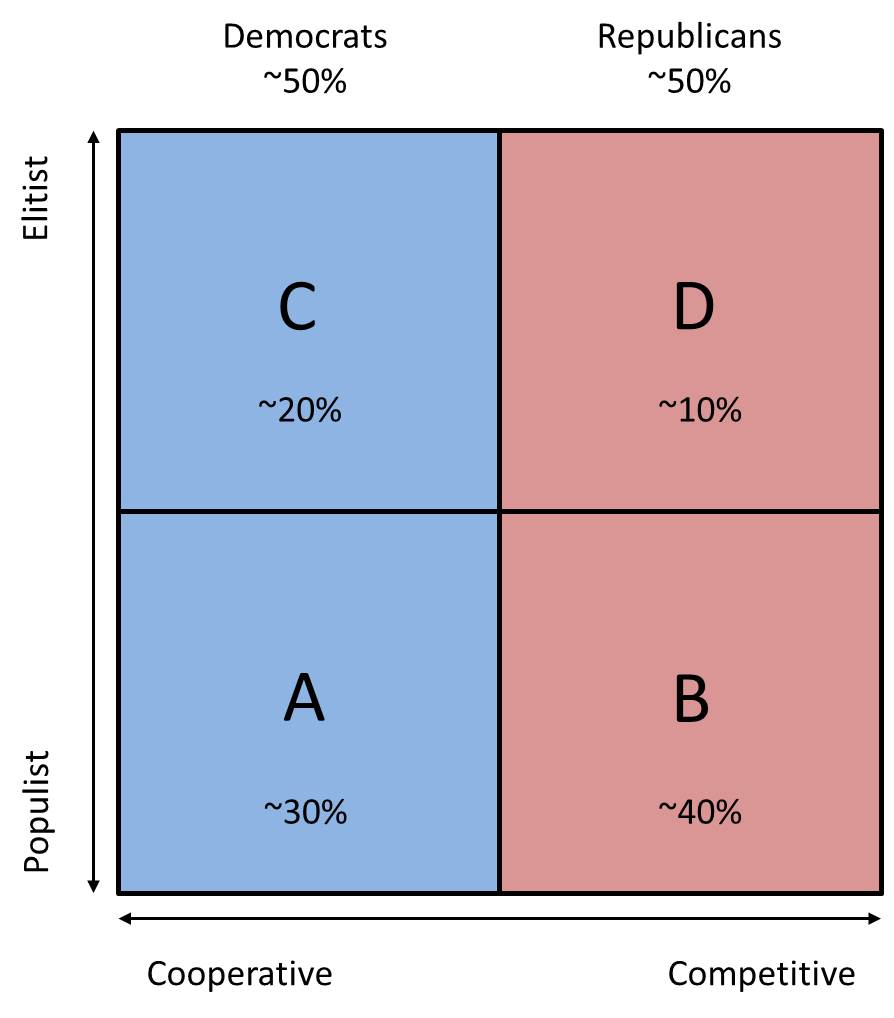
We can place presidents and candidates over the last 40 years into this framework:

As populist discontent has grown, it has become more difficult to win elections without a populist message. At the same time, given the amount of money required to win and the elite bias of the media, it has remained impossible for true populists to gain traction. As a result, our last two presidents have been elitists with populist messaging, from a cooperative (Obama) and competitive (Trump) perspective, and the losers have been elitists who failed to connect with the lower classes (McCain, Romney, Hillary Clinton). There is a lot of hand-wringing about Obama-Trump voters: those people who voted for Obama in 2008 and 2012 and for Trump in 2016. The media can’t understand, or doesn’t want us to understand, that it is possible for prioritize the populist-elitist distinction over the cooperative-competitive distinction. That would open up the possibility of a realignment of the quadrants in a way that would create a populist majority, which is something that the elite would like to avoid at all costs.
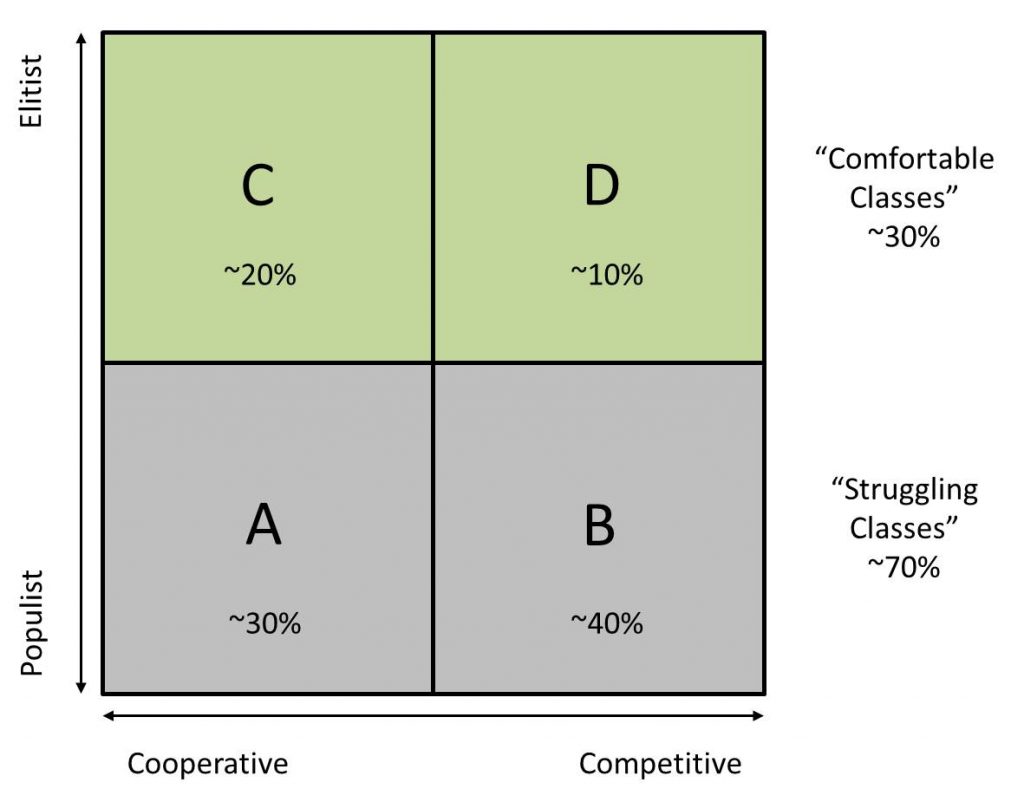
In the context of racial prejudice, the media tends to portray this narrative:
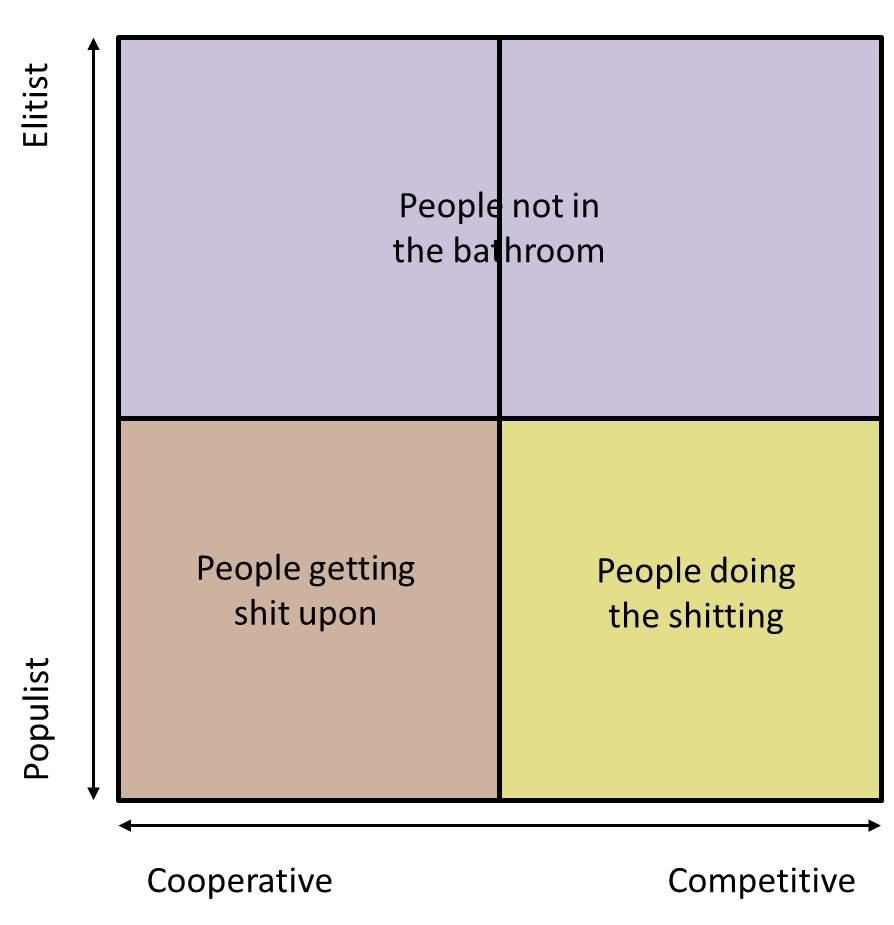
That is to say, it’s the hillbillies and rednecks who are the problem, the “deplorables”, the Proud Boys, the police, the attitudes of the ignorant and uneducated.
But if we dig a little deeper we can easily identify structural racism and implicit bias within the elite classes. Companies are less likely to hire Black applicants. Real estate agents are less likely to show good houses to Black families, and banks are less likely to offer them loans. Supposedly “liberal” and “accepting” whites are still alarmingly likely to call police on Black people simply going about their lives. And the list goes on. So in reality the picture looks more like this:
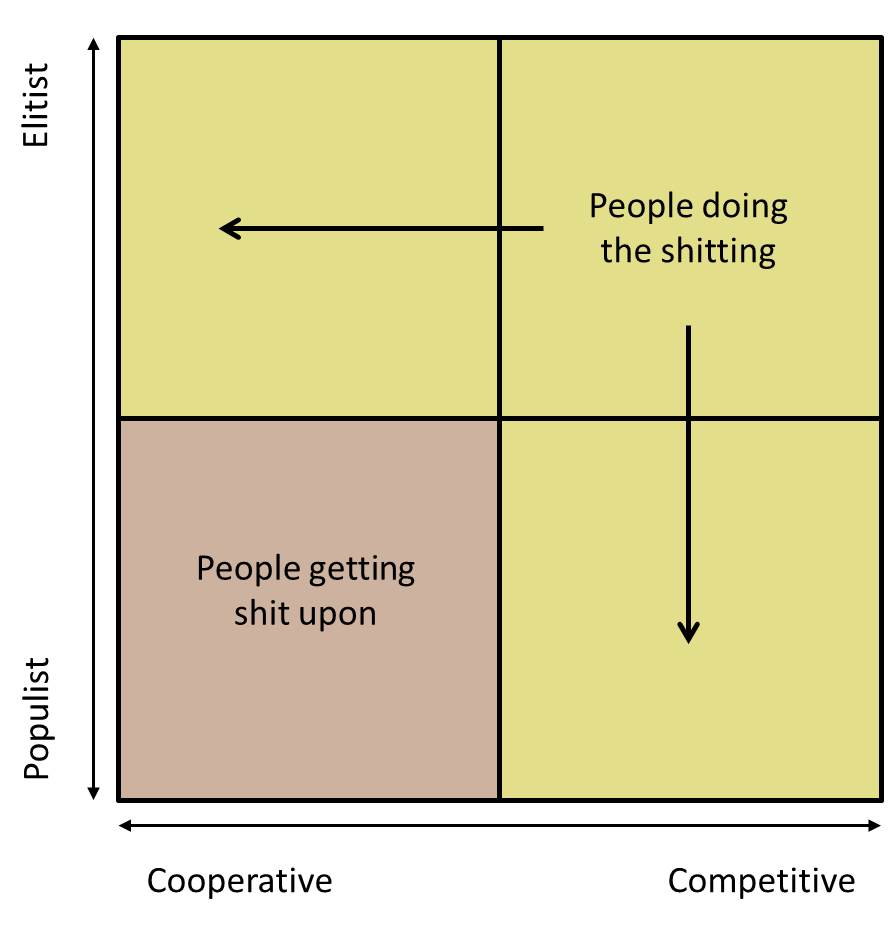
This isn’t the whole story, however, because race is not the only axis of oppression in American society. From an economic perspective, anyone outside the comfortable classes is feeling some pain. Between rising costs and stagnant wages, the purchasing power of the lower half of American society has been declining for the last 20 years or so, leaving retirement accounts empty, families forced to downsize, and only 41% of people with sufficient savings to cover a $1000 emergency – while at the same time the wealth of the comfortable classes continues to increase. So viewed from an economic lens, the picture looks more like this:
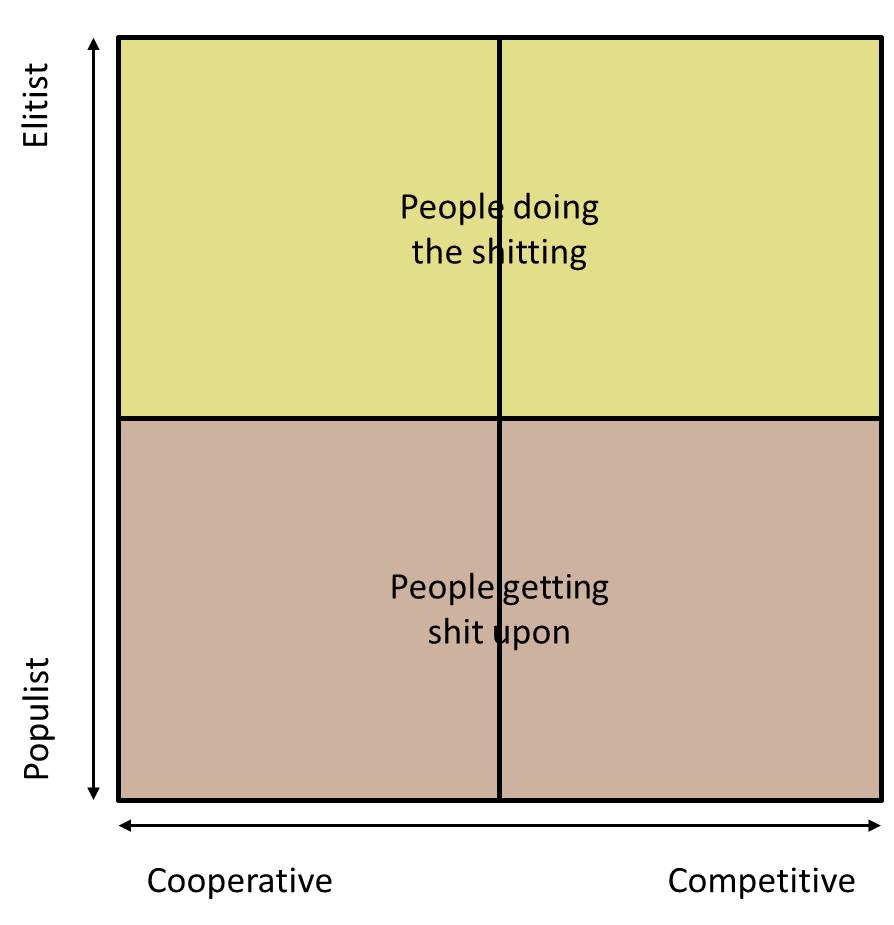
Elitism extends this divide beyond dollars and cents to the realm of social interactions. In order for the elite to feel justified in their wealth, they must also feel that they are deserving of it while the lower classes are not, or else that something other than economics is preventing the lower classes from rising. For quadrant D this is fairly straightforward: life is a struggle and they are the winners and therefore entitled to the spoils. For quadrant C this requires considerable mental gymnastics to maintain a cooperative mindset while supporting an economic system that generates oppression. These people tend to tell a story that quadrant A is oppressed by quadrant B (i.e. racism and white supremacy), and that if only that oppression could be resolved immigrants and people of color would be freed to rise into the comfortable classes. Meanwhile people in quadrant B are judged as bigoted racists and therefore deserving of their lower-class status.
It is of paramount importance to the comfortable classes that the struggling classes, which represent a solid majority, not be allowed or encouraged to find common cause. So it is that we have a fragile balance of halfhearted alliances and open enmities that maintains the balance of power and looks something like this:
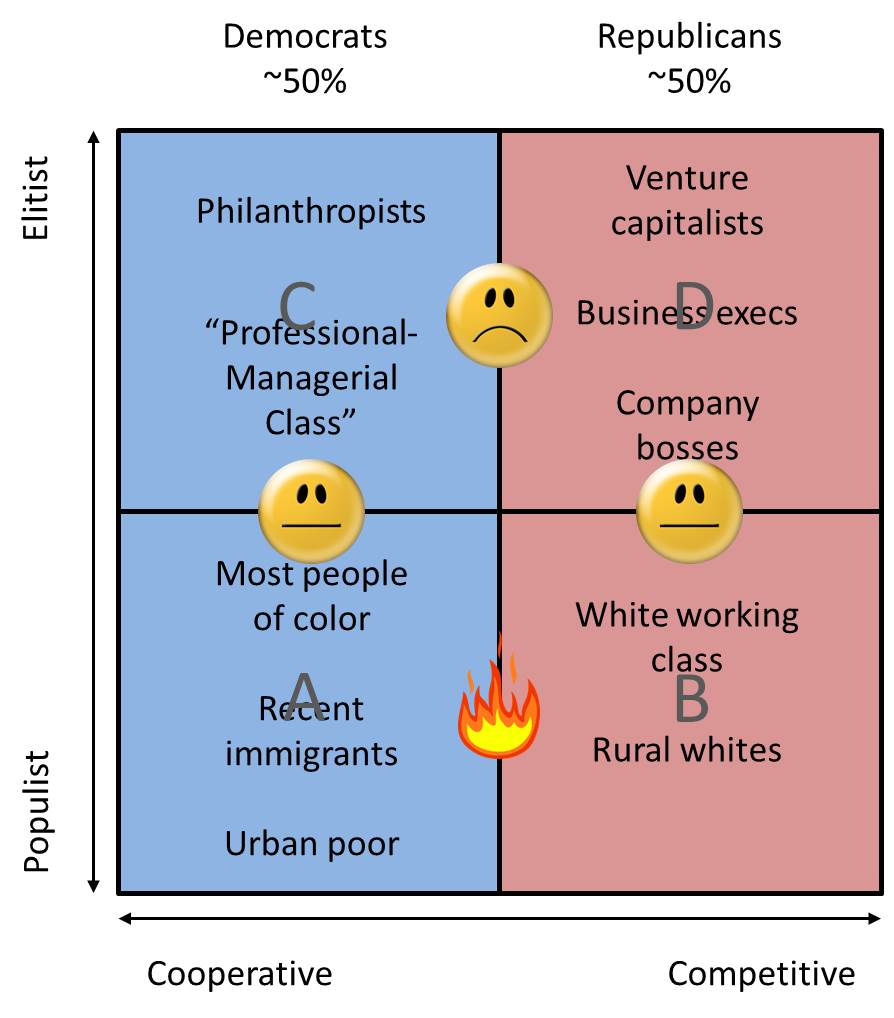
It is worth examining these inter-group relationships in a bit more detail to understand this state of affairs.
Quadrant A, composed largely of people of color, is not given any great options. Quadrant C promises opportunities for advancement and protection against discrimination, but at the same time continues to charge the same unaffordable rent and to prop up the economic system that exploits their labor at unlivable wages. But an alliance with them is at this point preferable to the hatred flung their way by quadrant B.
Quadrant B, the white working class, includes a few dyed-in-the-wool bigots and racists, but is largely composed of good-hearted people who have a love of tradition, a nostalgia for the good old days when they earned reasonable wages, and a real but generally nonthreatening discomfort with people who are “different”. I know this because these were the people I grew up with, the people who I still call friends, the people who cared for my father when he was dying. Their antipathy toward A seems to me to be largely a result of actions by the elite quadrants C and D.
The framework of social justice is largely a product of universities, whose faculty and students are primarily in quadrant C. To avoid having to deal with the implications of their economic privilege, economic oppression is conveniently omitted from their framework. This angers the white working class, who are told that the suffering they are experiencing is either not real or their own fault, given that they do not have any “axes of oppression.”
Quadrant D, and especially Donald Trump, recognized the rejection of the white working class by quadrant C liberal elites and offered an alliance. The substance of this tenuous alliance is loosely based around shared competitive values (e.g. “America First”) and social conservatism, but any potential camaraderie between these groups is impeded by the fact that D was (and remains) most responsible for the immiseration of B, through – among other things – automation, offshoring of jobs, and destruction of unions. In order to forge this alliance, D had to offer B a convincing alternative scapegoat for their anger, and so was born the dangerous messaging that “illegal aliens are taking your jobs” and “black criminals on welfare are living high on the dole while you work hard for your money” and any number of other falsehoods.
Elite quadrants C and D disagree loudly on various issues – their voices are the ones we hear in the media – but they agree that preserving the economic status quo is a priority and also that growing populist dissent and discontent represents a threat to their power and wealth. Thus keeping a fire burning between A and B is very much in their shared interest.
The A-C and B-D alliances are beginning to weaken. For all that Donald Trump is a B-D bridge at the moment, he cannot ultimately improve the situation for B without making changes that will impact himself and his wealthy quadrant D cronies, and so the alliance seems doomed to failure. For all that the folks of C are doing their part to be allies to A during the current protests, when the discussion moves beyond racism and police brutality to affordable housing and jobs that pay a living wage the support will quietly evaporate.
At the same time, immigrants, people of color, and working class whites are toiling together daily in construction sites and factories, food processing plants and hotels, and increasingly recognizing their shared humanity and their common cause in restoring respect, dignity, and adequate pay to their essential contribution to society. So it is that I expect, within the next years to decades, to see a realignment of political alliances in the United States which will open the door to the possibility of real economic reform.
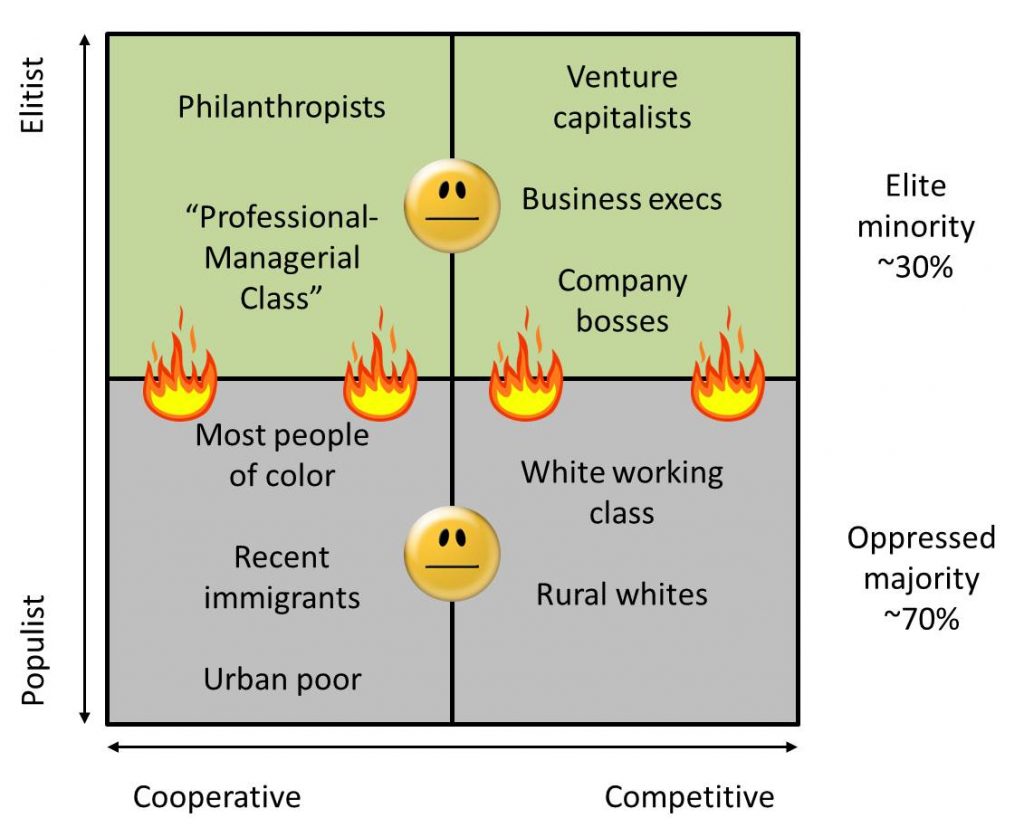
To get a sense of what that reform might look like, we first need to understand how our economy exploits some to benefit others, and apply the framework of social justice to attach moral significance to economic decisions. We’ll continue with Part II: The American Dream Casino.

One Response to Toward a More Equal America